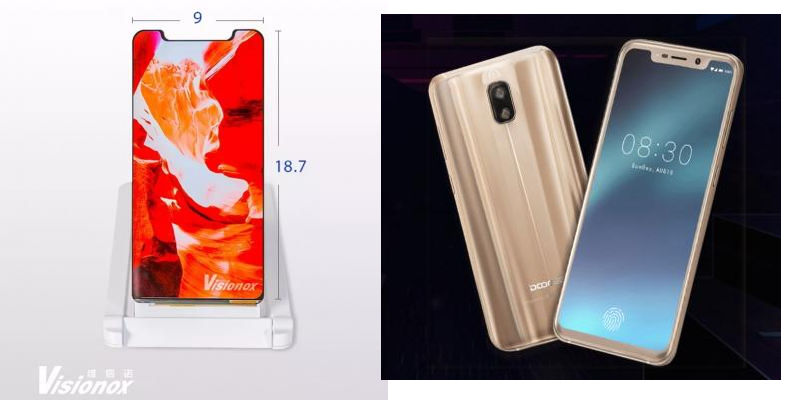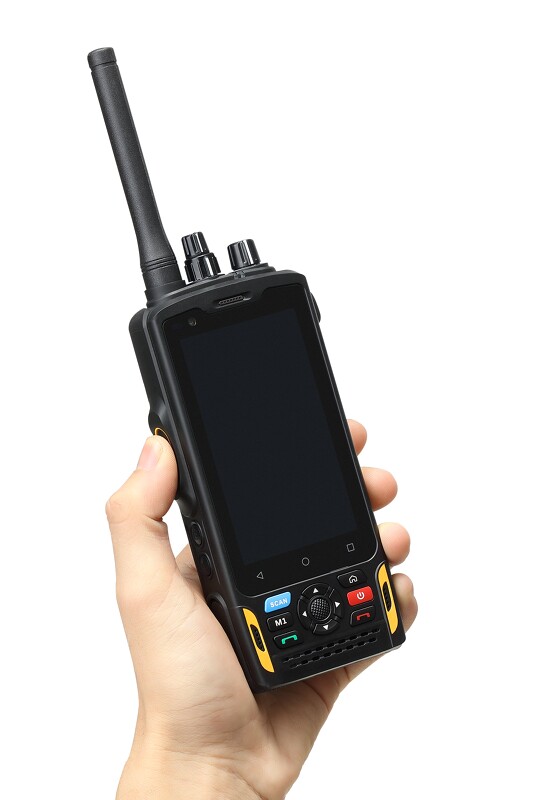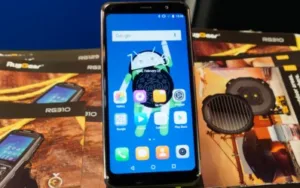After the really big shows there are always a few items that ‘slip through the net’ at the time we finalise our show report, so we like to catch up so that as little as possible gets missed.
We didn’t see it at the show, but apparently, Doogee of China had the Doogee V smartphone which uses a new 6.2″ notch-type OLED from Visionox.
 The Doogee V uses an AMOLED from Visionox
The Doogee V uses an AMOLED from Visionox
General Mobile of Turkey is a supplier of volume and entry level markets and had its fifth Android One model, the “GM 8” and the “GM 8 Go” which runs Android Go, which can run in just 1GB of memory. The company had a small event on the showfloor to launch the new models.
Hangar18 of Croatia was showing its Noa smartphones. The N10 flagship model has a 6.2″ FullHD+ 18:9 display with a notch. The LCD has incell touch and we found this short video of the phone, that shows that there are no changes to Android at the moment to accommodate the shape of the display. The phone uses an MT6763 with 4GB/64GB and with dual Sony IMX499 cameras. The battery is 3,600 mAh. It is expected to cost around €300. The company also showed the N1 (5.5″, HD+ 18:9, MT6739, 2GB/16GB, 3,000mAh, 13mp+5mp, 5mp, €150) and the N7 (5.7″ HD+ 18:9, MT6750, 4GB/64GB, 3,300mAh, 16mp+16mp, 16mp IMX298. €250). The N1 and N7 are due around April.
Mara Corp was reported to have been at MWC with Google. The company is developing the Mara X phone for the market in Africa and was announced with Google as part of the Android One portfolio. Mara started in Uganda and now has 14,000 staff in 25 countries. We had not received more details at press time.
RealNetworks said at the show that its RealMedia HD codec will be used by China International Broadcasting Network (CIBN) for OTT TV, one of seven networks licensed for OTT delivery in China. The codec will be used for 1080P and UltraHD content. CIBN said that the codec “provides major advantages in terms of lower bitrate and higher image quality when compared to other existing applications in the market”. The company claims that efficiency is 30% – 45% compared to H.264. It also claims lower CPU usage and battery consumption compared to H.265.
RugGear was showing a new rugged smartphone, the RG85. The display is a 5.99″ LCD with 18:9 format and Gorilla Glass and runs on a Snapdragon 430 with 3GB of RAM and 32GB of ROM (although staff told us it used a rigid OLED). The housing is a special polycarbonate and the phone is tested to Mil-Std 810G and is rated to work from -20ºC to + 60ºC. An unusual feature is that away from GSM networks, it can be used as a ‘Push to Talk’ walkie-talkie. The battery is 4,000 mAh and the touch is designed to be usable with gloves or wet/dirty fingers. There are 12mp (main) and 8mp (selfie) cameras. Connectivity is via USB Type-C.
An unusual feature is a 100dB output from the speaker so that calls can be heard in noisy environments. The phone will cost €399 and is planned for May.
 The RugGear RG850 is for outdoor and industrial use. Image:Meko
The RugGear RG850 is for outdoor and industrial use. Image:Meko
The RG760 is an unusual device as it comes with IP68 certification and a standard exchangeable 5,600 mAh battery with a 10,000 mAh option. The display is a 4″ unit with WVGA and using Gorilla Glass. The phone has access to the Private LTE Band 31, so it can be used with private base stations over a 50km² area (and is the first Android phone to do this). Like the RG850 it can be used in walkie talkie mode. It can also be supplied with hardware encryption. It uses a Snapdragon 625 with 3GB/32GB and has 13mp and 5mp cameras. The extra bright flash can be used as a torch.

The Seamless Air Alliance said at the show that Airbus, Delta, OneWeb, Sprint and Bharti Airtel (“Airtel”) have launched their organisation to develop easy to use, high speed internet connectivity when travelling by air. The group wants to build on the low latency and high speed of 5G.

TDK announced at the show that it has agreed to acquire Chirp Microsystems which, like Elliptic Labs, uses ultrasound to track motion and gestures. TDK sees the technology as adding to its sensor ecosystem based on piezo-ceramics and mems devices.
Vivo was listed at eight different locations (most of them private meeting rooms), but we didn’t spot them at the show! However the company was apparently showing its Apex smartphone (concept – it’s not yet a commercial product) which is said to have side bezels of 1.8mm and a bottom bezel of 4.2mm with a flexible OLED with drivers mounted on the display, and with an aim in the future to get to 1.8mm all around (which would mean 98% screen to body). The display has a 5.99″ diagonal with 2160 and it has an integrated fingerprint scanner which is very big. The front camera is an 8mp unit that is self-elevating that pops up in 0.6 seconds. The display also acts as a speaker. The Apex is based on a Snapdragon 645. (we thought we’d found the resolution of the display, but it seems to be describe as 2160 x 1440, which is wrong, clearly. However, we found other references to it at 2160 x 1080, which seems reasonable.)
The Verge managed to catch up with Vivo and there is a good video below of the Apex. It’s worth a look.

